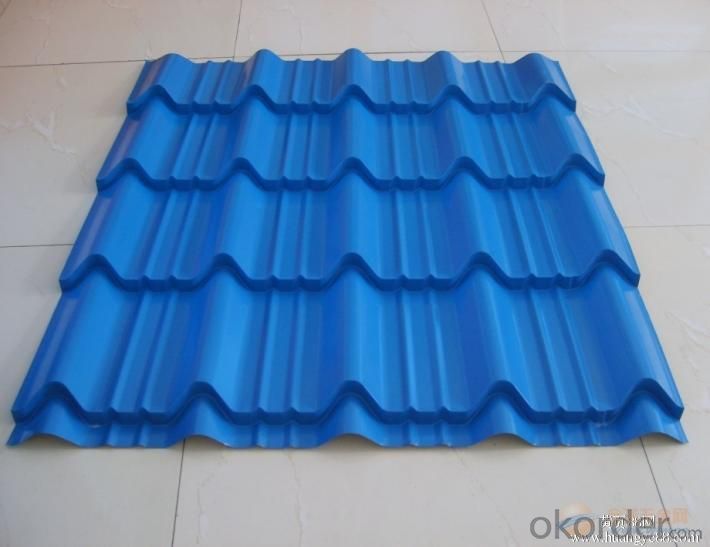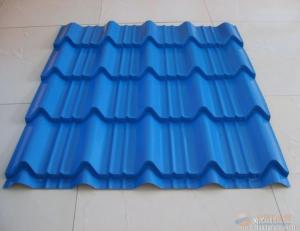Pre-Painted Galvanized / Aluzinc Corrugated Steel Sheet Royal Blue
- Loading Port:
- Tianjin
- Payment Terms:
- TT or LC
- Min Order Qty:
- 50 m.t.
- Supply Capability:
- 10000 m.t./month
OKorder Service Pledge
OKorder Financial Service
You Might Also Like
1. Pre-Painted Galvanized/Aluzinc Steel Coil Description:
With GI as base material, after pretreatment (degrease and chemical treatment ) and liquid dope with several layers of color, then after firing and cooling, finally the plate steel is called pre-painted galvanized (aluzinc) steel.
Pre-painted galvanized steel is good capable of decoration, molding, corrosion resistance.
It generally displays superior workability, durability and weather resistance.
2.Main Features of the Pre-Painted Galvanized/Aluzinc Steel Coil:
• Excellent process capability
• Smooth and flat surface
• Workability, durability
• Excellent heat resistance performance
• High strength
• Good formability
• Good visual effect
3.Pre-Painted Galvanized/Aluzinc Steel Coil Images

4.Pre-Painted Galvanized/Aluzinc Steel Coil Specification
| Standard | AISI, ASTM, BS, DIN, GB, JIS |
| Grade | DX51D, DX52D |
| Thickness | 0.17-2.0mm |
| Model Number | coil |
| Type | Steel Coil |
| Technique | Cold Rolled |
| Surface Treatment | Coated |
| Application | Roofing |
| Special Use | High-strength Steel Plate |
| Width | 20-1250mm |
| Length | customized |
| Commoidty | pre-painted galvanized steel coil |
| Thickness | 0.13-2.0mm |
| Width | 20-1250mm |
| Zinc Coating | 40-180g/m2 |
| Printing Thickness | top side: 20+/-5 microns, back side: 5-7 microns |
| Color | All RAL color |
| Surface Treatment | color coated |
| Coil Weight | 4-7 tons |
| Coil ID | 508/610mm |
| Packaging | standard seaworthy packing |
5.FAQ of Pre-Painted Galvanized/Aluzinc Steel Coil
1) What’s the application of this product?
Roof, roof structure, surface sheet of balcony, frame of window, etc.
2) What’s the brand of the paint?
We use the best brand of all of the word—AKZO.
3) How about your company?
A world class manufacturer & supplier of castings forging in carbon steel and alloy steel,is one of the large-scale professional investment casting production bases in China,consisting of both casting foundry forging and machining factory.
Annually more than 8000 tons Precision casting and forging parts are exported to markets in Europe,America and Japan.
OEM casting and forging service available according to customer’s requirements.
4) How to guarantee the quality of the products?
We have established the international advanced quality management system,every link from raw material to final product we have strict quality test;We resolutely put an end to unqualified products flowing into the market. At the same time, we will provide necessary follow-up service assurance.
5) How long can we receive the product after purchase?
Usually within thirty working days after receiving buyer’s advance payment or LC.
We will arrange the factory manufacturing as soon as possible. The cargo readiness usually takes 15-25 days, but the shipment will depend on the vessel situation.
- Q:What is the difference between a hot rolled and cold rolled galvanized steel sheet?
- The main difference between a hot rolled and cold rolled galvanized steel sheet lies in the manufacturing process and the resulting properties of the finished product. Hot rolled galvanized steel sheets are made by heating a large steel slab or billet above its recrystallization temperature, which is typically around 1700°F (926°C). This high temperature allows the steel to be easily shaped and formed into the desired thickness and dimensions. The hot rolling process also helps to refine the grain structure of the steel, resulting in improved mechanical properties and a more uniform distribution of alloying elements. On the other hand, cold rolled galvanized steel sheets are manufactured at room temperature by passing the hot rolled sheet through a series of rollers that compress and shape the material. This process not only reduces the thickness of the sheet but also increases its tensile strength and improves its surface finish. Cold rolling also allows for tighter tolerances and more precise dimensions, making it suitable for applications that require high precision and consistency. In terms of properties, hot rolled galvanized steel sheets tend to have a rougher surface finish due to the high temperature processing. However, they are generally more ductile and easier to form or bend compared to cold rolled sheets. Hot rolled sheets also have a slightly thicker oxide layer on the surface, which provides some additional corrosion resistance. Cold rolled galvanized steel sheets, on the other hand, have a smoother and more polished surface finish. They are typically thinner and have a higher strength-to-weight ratio compared to hot rolled sheets. The cold rolling process also results in a more homogeneous microstructure, which can improve the overall mechanical properties of the steel, such as hardness and toughness. Overall, the choice between hot rolled and cold rolled galvanized steel sheet depends on the specific requirements of the application. Hot rolled sheets are often preferred for applications that require easy formability and a rougher surface finish, while cold rolled sheets are favored for their higher strength, tighter tolerances, and smoother surface finish.
- Q:The differences and uses of cold rolling and hot rolling
- The free torsion rigidity of hot rolled steel is higher than that of cold rolled steel, so the torsion resistance of hot rolled steel is better than that of cold rolled steel
- Q:What is the process of electroplating steel sheets?
- The process of electroplating steel sheets involves immersing the steel sheets in a solution that contains metal ions, typically nickel or chromium. An electric current is then passed through the solution, causing the metal ions to be attracted to the steel sheets and deposit onto their surface. This creates a thin, protective layer of metal that enhances the steel sheets' appearance, corrosion resistance, and durability.
- Q:Are steel sheets suitable for automotive chassis?
- Yes, steel sheets are suitable for automotive chassis. Steel is a popular choice for automotive chassis due to its strength, durability, and affordability. It provides excellent structural integrity and can withstand the various forces and stresses experienced by a vehicle during operation. Steel sheets also offer good resistance to impacts, vibrations, and corrosion, making them ideal for use in automotive chassis. Additionally, steel is a readily available material and can be easily formed, welded, and molded into different shapes and sizes, allowing for flexibility in design and manufacturing processes. Overall, steel sheets are a reliable and widely used material in the automotive industry for constructing chassis that meet the required safety, performance, and longevity standards.
- Q:What are the color options for steel sheets?
- The color options for steel sheets can vary, but some common choices include silver, black, white, gray, and various shades of metallic colors such as bronze or copper. Additionally, steel sheets can also be painted or coated with a variety of colors to suit specific preferences or design requirements.
- Q:Can steel sheets be used in the telecommunications industry?
- Yes, steel sheets can be used in the telecommunications industry. Steel sheets are often used for constructing telecommunication towers and mast structures due to their strength, durability, and ability to withstand harsh weather conditions.
- Q:Can steel sheets be used for automotive wheels?
- Yes, steel sheets can be used for automotive wheels. Steel wheels are commonly used in vehicles due to their durability and cost-effectiveness. However, it is important to note that steel wheels are typically heavier than other materials such as aluminum alloy, which may impact the vehicle's performance and fuel efficiency.
- Q:How much is one meter for laser cutting steel plates?
- The length and width are smaller than 300MM and the thickness is less than 12MM, because of good nesting material, we provide. By weight, the carbon steel is 8~9 yuan per kilogram and the quantity is large, 7~8 yuan per kilogram.
- Q:Can the steel sheets be used for skylights or roof windows?
- Yes, steel sheets can be used for skylights or roof windows. Steel is a strong and durable material that can withstand various weather conditions, making it suitable for these applications. Additionally, steel sheets can be fabricated and designed to meet the specific requirements of skylights or roof windows. They can be installed to provide natural light and ventilation while maintaining the structural integrity of the building. However, it is important to ensure proper insulation and glazing to prevent heat loss or gain and to optimize energy efficiency.
- Q:What is the process of embossing on steel sheets?
- The process of embossing on steel sheets involves creating raised or recessed designs on the surface of the steel. This technique is commonly used to add texture, improve aesthetics, or enhance the mechanical properties of the steel. The first step in the embossing process is preparing the steel sheets. This typically involves cleaning the surface to remove any dirt, oils, or coatings that may interfere with the embossing process. The steel sheets are then carefully inspected for any imperfections or surface defects that could affect the embossing quality. Once the steel sheets are prepared, they are placed in an embossing machine, which consists of two or more rollers. These rollers have engraved patterns on their surfaces, which will be transferred onto the steel sheets. The rollers are typically made of hardened steel or other materials that are resistant to wear and tear. As the steel sheets pass through the embossing machine, pressure is applied to the rollers, causing them to press against the steel surface. This pressure creates a plastic deformation in the sheet, resulting in the desired raised or recessed pattern. The depth and intensity of the embossing can be adjusted by controlling the pressure applied by the rollers. In some cases, heat may be applied during the embossing process to soften the steel sheets and make them more malleable. This allows for deeper and more intricate embossing patterns to be achieved. The temperature and duration of the heating process will depend on the specific type of steel being used and the desired outcome. After the embossing process is complete, the steel sheets may undergo additional treatments such as cleaning, coating, or polishing to further enhance their appearance and protect them from corrosion. These finishing steps help to ensure that the embossed steel sheets meet the desired quality standards and are ready for their intended application. Overall, the process of embossing on steel sheets is a versatile and effective way to add texture and visual interest to the surface of the steel. It requires careful preparation, precision machinery, and skilled operators to achieve consistent and high-quality results.
1. Manufacturer Overview |
|
|---|---|
| Location | |
| Year Established | |
| Annual Output Value | |
| Main Markets | |
| Company Certifications | |
2. Manufacturer Certificates |
|
|---|---|
| a) Certification Name | |
| Range | |
| Reference | |
| Validity Period | |
3. Manufacturer Capability |
|
|---|---|
| a)Trade Capacity | |
| Nearest Port | |
| Export Percentage | |
| No.of Employees in Trade Department | |
| Language Spoken: | |
| b)Factory Information | |
| Factory Size: | |
| No. of Production Lines | |
| Contract Manufacturing | |
| Product Price Range | |
Send your message to us
Pre-Painted Galvanized / Aluzinc Corrugated Steel Sheet Royal Blue
- Loading Port:
- Tianjin
- Payment Terms:
- TT or LC
- Min Order Qty:
- 50 m.t.
- Supply Capability:
- 10000 m.t./month
OKorder Service Pledge
OKorder Financial Service
Similar products
New products
Hot products
Related keywords





























